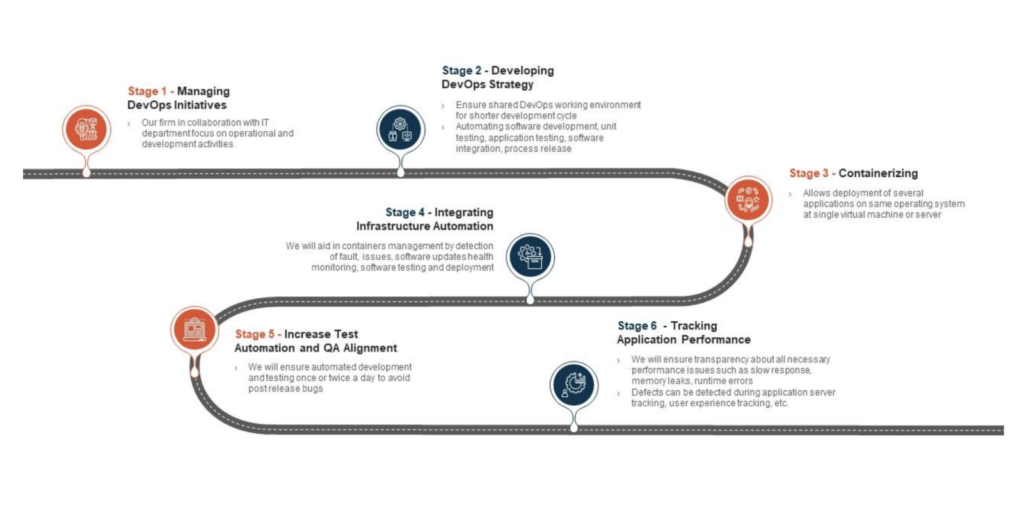DevOps is a set of practices that combine software development (Dev) and IT operations (Ops) to deliver software products and services more efficiently and with better quality. In recent years, DevOps has become a popular approach to software development, and it has been adopted by many organizations worldwide. DevOps aims to break down silos and improve collaboration between development and operations teams, automate processes, and enable continuous delivery and deployment.
In this post, we will discuss the benefits of DevOps, how to start implementing it, the strategies to use and the tools that can be used.
Benefits of DevOps
DevOps offers many benefits to organizations, including:
- Faster Time to Market: DevOps helps to reduce the time it takes to deliver software products and services to the market. By breaking down silos between teams and automating processes, DevOps enables continuous delivery and deployment, reducing the time to market.
- Improved Collaboration: DevOps improves collaboration between development and operations teams, leading to better communication and faster problem-solving. This collaboration helps to improve the quality of software products and services.
- Improved Quality: DevOps helps to improve the quality of software products and services by enabling continuous testing and feedback. By automating testing and feedback, DevOps helps to identify and fix issues early, reducing the risk of defects in production.
- Greater Efficiency: DevOps helps to improve the efficiency of software development and operations by automating repetitive tasks, reducing manual effort and errors, and optimizing processes.
- Improved Customer Satisfaction: DevOps helps to improve customer satisfaction by delivering software products and services faster, with better quality, and with fewer defects.
How to Start Implementing DevOps
Implementing DevOps is not a one-time project; it’s a continuous process of improvement. Here are some steps to help you get started with implementing DevOps:

- Assess Your Current Process: The first step in implementing DevOps is to assess your current process. Identify the areas that need improvement, and prioritize the improvements based on their impact on your business.
- Define Your Goals: Define your DevOps goals based on your business objectives. Identify the key performance indicators (KPIs) that you will use to measure your progress.
- Establish a DevOps Culture: Establish a DevOps culture that emphasizes collaboration, communication, and continuous improvement. Encourage your teams to work together and share knowledge and ideas.
- Automate Your Processes: Automate your processes as much as possible to reduce manual effort and errors. Use tools like Jenkins, GitLab, and CircleCI to automate your build, test, and deployment processes.
- Monitor Your Performance: Monitor your performance regularly using your KPIs. Use tools like Prometheus, Grafana, and Kibana to monitor your application and infrastructure performance.
- Continuously Improve: DevOps is a continuous process of improvement. Continuously assess your process and performance, and make adjustments to achieve your goals.
Strategies to Use in DevOps
There are several strategies that organizations can use to implement DevOps successfully. Some of these strategies include:
- Infrastructure as Code: Infrastructure as Code (IaC) is a strategy that enables you to automate your infrastructure provisioning and management. Use tools like Terraform and CloudFormation to define your infrastructure as code and manage it using version control systems.
- Continuous Integration: Continuous Integration (CI) is a strategy that enables you to automate your build and test processes. Use tools like Jenkins, Travis CI, and CircleCI to automate your build and test processes.
- Continuous Delivery: Continuous Delivery (CD) is a strategy that enables you to automate your deployment processes. Use tools like Kubernetes, Docker, and Helm to deploy your applications to production automatically.
- Microservices Architecture: Microservices architecture is a strategy that enables you to break down your application into smaller, independent services. This strategy helps to improve scalability, resilience, and agility.
- DevSecOps: DevSecOps involves integrating security into the entire software development process, rather than treating it as a separate step. This helps ensure that security is considered at every stage of development and deployment.
- Monitoring and Logging: Monitoring and logging are strategies that enable you to track and analyze the performance and behavior of your application and infrastructure. Use tools like Prometheus, Grafana, Kibana, and ELK Stack to monitor and log your application and infrastructure.
Tools for DevOps
There are many tools available for DevOps, both open source and paid. Here are some popular DevOps tools:

- GitLab: GitLab is a complete DevOps platform that provides tools for source code management, CI/CD, monitoring, and more.
- Jenkins: Jenkins is an open-source automation server that provides CI/CD capabilities.
- Travis CI: Travis CI is a cloud-based CI/CD platform that integrates with GitHub.
- Kubernetes: Kubernetes is an open-source container orchestration platform that enables you to deploy, scale, and manage containerized applications.
- Docker: Docker is a platform for building, shipping, and running applications in containers.
- Ansible: Ansible is an open-source automation platform that enables you to automate your infrastructure provisioning and management.
- Terraform: Terraform is an open-source tool for provisioning and managing infrastructure as code.
- Prometheus: Prometheus is an open-source monitoring system that provides metrics, alerts, and visualization for your application and infrastructure.
- Grafana: Grafana is an open-source platform for monitoring and analyzing metrics and logs.
- ELK Stack: The ELK Stack is a set of open-source tools (Elasticsearch, Logstash, and Kibana) that enables you to collect, store, and analyze logs.
Conclusion
DevOps is a valuable service that can help organizations improve their software development and operations. DevOps offers many benefits, including faster time to market, improved collaboration, improved quality, greater efficiency, and improved customer satisfaction. To implement DevOps successfully, organizations should assess their current process, define their goals, establish a DevOps culture, automate their processes, monitor their performance, and continuously improve. There are many strategies and tools available for DevOps, and organizations should choose the ones that best fit their needs and goals. If you’re interested in DevOps services, please contact us to learn how we can help you achieve your goals.


